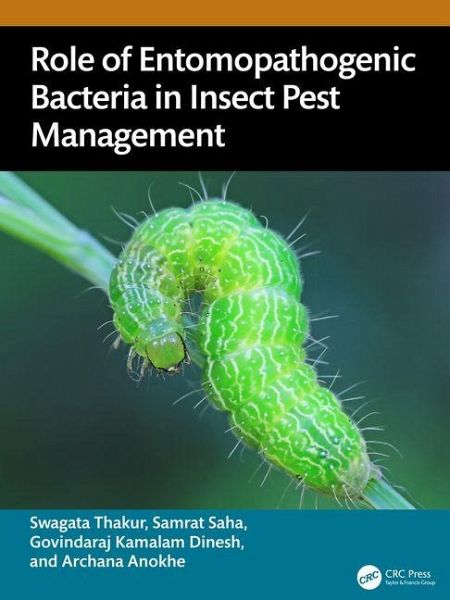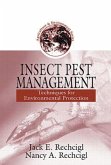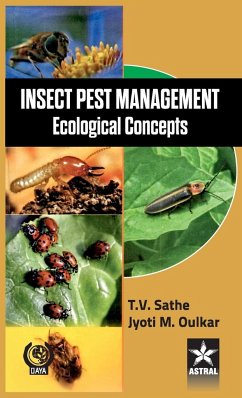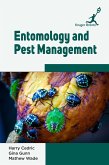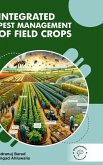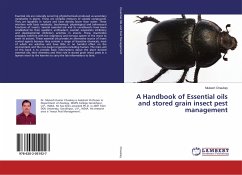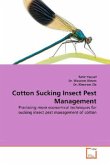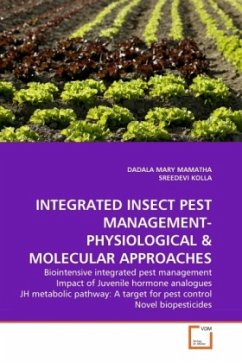Archana Anokhe, Govindaram Kamalam Dinesh, Samrat Saha, Swagata Thakur
Role of Entomopathogenic Bacteria in Insect Pest Management
Archana Anokhe, Govindaram Kamalam Dinesh, Samrat Saha, Swagata Thakur
Role of Entomopathogenic Bacteria in Insect Pest Management
- Gebundenes Buch
- Merkliste
- Auf die Merkliste
- Bewerten Bewerten
- Teilen
- Produkt teilen
- Produkterinnerung
- Produkterinnerung
This book highlights the important contribution of entomopathogenic bacteria in transforming the management of insect pests. It meticulously details their mechanisms, historical development, and crucial role in Integrated Pest Management (IPM) strategies.
Andere Kunden interessierten sich auch für
![Insect Pest Management Insect Pest Management]() Jack E. Rechcigl / Nancy A. Rechcigl (eds.)Insect Pest Management253,99 €
Jack E. Rechcigl / Nancy A. Rechcigl (eds.)Insect Pest Management253,99 €![Insect Pest Management Insect Pest Management]() T V Sathe & Oulkar Jyoti MInsect Pest Management81,99 €
T V Sathe & Oulkar Jyoti MInsect Pest Management81,99 €![Entomology and Pest Management Entomology and Pest Management]() Herry CedricEntomology and Pest Management114,99 €
Herry CedricEntomology and Pest Management114,99 €![Integrated Pest Management Of Field Crops Integrated Pest Management Of Field Crops]() Indranuj BaradIntegrated Pest Management Of Field Crops63,99 €
Indranuj BaradIntegrated Pest Management Of Field Crops63,99 €![A Handbook of Essential oils and stored grain insect pest management A Handbook of Essential oils and stored grain insect pest management]() Mukesh ChaubeyA Handbook of Essential oils and stored grain insect pest management34,99 €
Mukesh ChaubeyA Handbook of Essential oils and stored grain insect pest management34,99 €![Cotton Sucking Insect Pest Management Cotton Sucking Insect Pest Management]() Tahir YousafCotton Sucking Insect Pest Management33,99 €
Tahir YousafCotton Sucking Insect Pest Management33,99 €![INTEGRATED INSECT PEST MANAGEMENT-PHYSIOLOGICAL & MOLECULAR APPROACHES INTEGRATED INSECT PEST MANAGEMENT-PHYSIOLOGICAL & MOLECULAR APPROACHES]() Dadala M. MamathaINTEGRATED INSECT PEST MANAGEMENT-PHYSIOLOGICAL & MOLECULAR APPROACHES40,99 €
Dadala M. MamathaINTEGRATED INSECT PEST MANAGEMENT-PHYSIOLOGICAL & MOLECULAR APPROACHES40,99 €-
-
-
This book highlights the important contribution of entomopathogenic bacteria in transforming the management of insect pests. It meticulously details their mechanisms, historical development, and crucial role in Integrated Pest Management (IPM) strategies.
Hinweis: Dieser Artikel kann nur an eine deutsche Lieferadresse ausgeliefert werden.
Hinweis: Dieser Artikel kann nur an eine deutsche Lieferadresse ausgeliefert werden.
Produktdetails
- Produktdetails
- Verlag: Taylor & Francis Ltd
- Seitenzahl: 240
- Erscheinungstermin: 13. August 2025
- Englisch
- Abmessung: 234mm x 156mm
- Gewicht: 453g
- ISBN-13: 9781032731308
- ISBN-10: 1032731303
- Artikelnr.: 73390621
- Herstellerkennzeichnung
- Libri GmbH
- Europaallee 1
- 36244 Bad Hersfeld
- gpsr@libri.de
- Verlag: Taylor & Francis Ltd
- Seitenzahl: 240
- Erscheinungstermin: 13. August 2025
- Englisch
- Abmessung: 234mm x 156mm
- Gewicht: 453g
- ISBN-13: 9781032731308
- ISBN-10: 1032731303
- Artikelnr.: 73390621
- Herstellerkennzeichnung
- Libri GmbH
- Europaallee 1
- 36244 Bad Hersfeld
- gpsr@libri.de
Swagata Thakur Swagata Thakur is currently pursuing PhD in Plant Pathology at the Indian Agricultural Research Institute. She has qualified for ICAR AIEEA-PG (Indian Council of Agricultural Research All India Entrance Examination for Agriculture - Post Graduation), 2020, in Plant Science with All India Rank (AIR) 16 and availed of Junior Research Fellowship for her M.Sc. from Indian Agricultural Research Institute. During her M.Sc. tenure, she worked on phenotypic and molecular characterization of finger millet against blast disease caused by Pyricularia grisea and gained expertise in finger millet pathology and molecular biology. She has also qualified for ICAR AICE-JRF/SRF (All India Competitive Examinations Junior Research Fellowship, Senior Research Fellowship), 2022, in Plant Pathology with AIR 10, and availing a Senior Research Fellowship. She has also availed DST-INSPIRE fellowship and cleared the ASRB-NET, UGC-NET, and DBT-BET examinations. During her PhD, she is working on the bakanae disease of rice and availing expertise in rice pathology and molecular biology. She has published two research articles, several popular articles/technical articles and book chapters, attended and presented her research works at several national and international conferences and received the Best Oral and Poster Presentation award. Samrat Saha Samrat Saha has completed his B.Sc. in Agriculture in 2020 and M.Sc. in Agricultural Entomology in 2022 from Uttar Banga Krishi Viswavidyalaya. He is currently pursuing Ph.D. in the Department of Entomology at Uttar Banga Krishi Viswavidyalaya. He has gained his interest and expertise in the field of apiculture, bee ecology, behaviour, plant-pollinator interaction, and melissopalynology and has published several research articles, popular articles, and book chapters in different reputed journals, magazines, and publishers. He has qualified ASRB-NET, 2023. He has also participated in different national and international seminars and conferences and was awarded the Best Presentation awards. Dr. Govindaraj Kamalam Dinesh Dr G K Dinesh is working as an Assistant professor at SRM Institute of Science and Technology, Tamilnadu, India. He is contributing in environmental science immensely through his publications as well as scientific work. He secured All India 5th rank in the national level entrance. He also qualified for the National Eligibility test and received the National level IARI Senior Research Fellowship and UGC Research Fellowship for his higher study. He has experience in the Ecology of birds and insects and long-term impact assessment study on distillery effluent application on soil and crops. Currently working in the area of Conservation agriculture and Ecosystem services valuation. He attended and presented his research work at many national and international conferences and also received the 'Best oral paper presentation award'. He is also a recipient of the 'Young researcher award for Excellence in Research'. He published more than 70 scientific articles and 12 research papers in various national and international journals and magazines. He is currently editing a book on the microbes and microbiomes for ecosystem restoration, to be published by Bentham Science Publishers. Dr. Archana Anokhe Dr. Archana Anokhe working as a scientist in the Department of Entomology at the Indian Agricultural Research Institute, New Delhi, Under the Ministry of Agriculture and farmers welfare. She was also a visiting scholar at the Agricultural Research Organisation (ARO), in Israel. She has qualified for a Junior research fellowship with all India rank (AIR) 13, Senior research fellowship with AIR-4, and agricultural research services with AIR -8; she was awarded the Women Scientist Award in 2022, Young Scientist award-2021, Best PhD thesis award-2020, Best student Award-2019, Best oral presentation award at National entomologist meet-2015 and Best poster presentation in Indo-US International conference- 2017. She was also awarded a National Talent scholarship and a UGC National fellowship during her graduation and PhD, respectively. Apart from PhD, she has also undergone different degree programmes, such as Post graduate diploma in education Technology management and a Master of Arts in English. She has been involved in the teaching of courses like Insect pathology, Host plant resistance, Advances in host plant resistance, Pest of horticultural and plantation crops, insect ornithology, Forest entomology and Medical Entomology. She has published more than 10 research papers in National and International journals and also published more than 50 popular articles/ blogs and technical bulletins and is a member of many institutional committees. She has also been interviewed at Doordarshan and All India Radio. She is the associate editor of the Indian Journal of Entomology, Indian Entomologist magazine and Agro-titan magazine. Her area of specialization is insect pathology and virus-vector relationship studies
CH
1. Why Entomopathogenic Bacteria? CH
2. History of Entomopathogenic Bacteria.CH
3. Classification of Entomopathogenic Bacteria CH
4. Phylum Firmicutes: Bacillus thuringiensis an Overview CH
5. Phylum Firmicutes: Lysinibacillus sphaericus an Overview CH
6. Phylum Firmicutes: Paenibacillus popillae an Overview CH
7. Phylum Firmicutes: Other Entomopathogenic Bacteria CH
8. Phylum Proteobacteria CH
9. Phylum Actinobacteria CH
10. Phylum Tenericutes CH
11. Genetic Engineering of Entomopathogenic Bacteria for Sustainable Pest Management CH
12. An Overview of Bt Crops and Their Safety CH
13. Insects' Resistance to Entomopathogenic Bacteria CH
14. Selection Criteria and Legislation Procedure for Commercial Production of Entomopathogenic Bacteria CH
15. Mass Production and Commercial Formulation of Some Important Entomopathogenic Bacteria. CH
16. Ecological and Economical analysis of Entomopathogenic bacteria.CH
17. Possible Way Forward and Policy Perspectives of the Utilization of Entomopathogenic Bacteria as an Alternative to GM Crops and Insecticides
1. Why Entomopathogenic Bacteria? CH
2. History of Entomopathogenic Bacteria.CH
3. Classification of Entomopathogenic Bacteria CH
4. Phylum Firmicutes: Bacillus thuringiensis an Overview CH
5. Phylum Firmicutes: Lysinibacillus sphaericus an Overview CH
6. Phylum Firmicutes: Paenibacillus popillae an Overview CH
7. Phylum Firmicutes: Other Entomopathogenic Bacteria CH
8. Phylum Proteobacteria CH
9. Phylum Actinobacteria CH
10. Phylum Tenericutes CH
11. Genetic Engineering of Entomopathogenic Bacteria for Sustainable Pest Management CH
12. An Overview of Bt Crops and Their Safety CH
13. Insects' Resistance to Entomopathogenic Bacteria CH
14. Selection Criteria and Legislation Procedure for Commercial Production of Entomopathogenic Bacteria CH
15. Mass Production and Commercial Formulation of Some Important Entomopathogenic Bacteria. CH
16. Ecological and Economical analysis of Entomopathogenic bacteria.CH
17. Possible Way Forward and Policy Perspectives of the Utilization of Entomopathogenic Bacteria as an Alternative to GM Crops and Insecticides
CH
1. Why Entomopathogenic Bacteria? CH
2. History of Entomopathogenic Bacteria.CH
3. Classification of Entomopathogenic Bacteria CH
4. Phylum Firmicutes: Bacillus thuringiensis an Overview CH
5. Phylum Firmicutes: Lysinibacillus sphaericus an Overview CH
6. Phylum Firmicutes: Paenibacillus popillae an Overview CH
7. Phylum Firmicutes: Other Entomopathogenic Bacteria CH
8. Phylum Proteobacteria CH
9. Phylum Actinobacteria CH
10. Phylum Tenericutes CH
11. Genetic Engineering of Entomopathogenic Bacteria for Sustainable Pest Management CH
12. An Overview of Bt Crops and Their Safety CH
13. Insects' Resistance to Entomopathogenic Bacteria CH
14. Selection Criteria and Legislation Procedure for Commercial Production of Entomopathogenic Bacteria CH
15. Mass Production and Commercial Formulation of Some Important Entomopathogenic Bacteria. CH
16. Ecological and Economical analysis of Entomopathogenic bacteria.CH
17. Possible Way Forward and Policy Perspectives of the Utilization of Entomopathogenic Bacteria as an Alternative to GM Crops and Insecticides
1. Why Entomopathogenic Bacteria? CH
2. History of Entomopathogenic Bacteria.CH
3. Classification of Entomopathogenic Bacteria CH
4. Phylum Firmicutes: Bacillus thuringiensis an Overview CH
5. Phylum Firmicutes: Lysinibacillus sphaericus an Overview CH
6. Phylum Firmicutes: Paenibacillus popillae an Overview CH
7. Phylum Firmicutes: Other Entomopathogenic Bacteria CH
8. Phylum Proteobacteria CH
9. Phylum Actinobacteria CH
10. Phylum Tenericutes CH
11. Genetic Engineering of Entomopathogenic Bacteria for Sustainable Pest Management CH
12. An Overview of Bt Crops and Their Safety CH
13. Insects' Resistance to Entomopathogenic Bacteria CH
14. Selection Criteria and Legislation Procedure for Commercial Production of Entomopathogenic Bacteria CH
15. Mass Production and Commercial Formulation of Some Important Entomopathogenic Bacteria. CH
16. Ecological and Economical analysis of Entomopathogenic bacteria.CH
17. Possible Way Forward and Policy Perspectives of the Utilization of Entomopathogenic Bacteria as an Alternative to GM Crops and Insecticides

